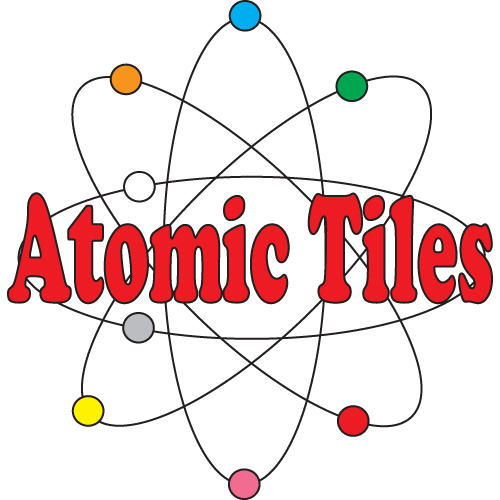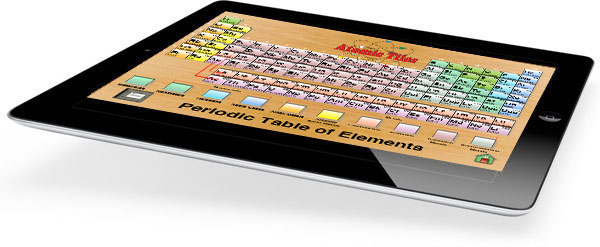

Introducing Atomic Tiles: an Exploration of Atoms and Molecules,designed by Dr. Seth Bush, Assistant Professor, Department of Chemistry, Cal Poly University, specializing in Chemical Education and developed by Dr. Fred Ventura, Ventura Educational Systems.
Atomic Tiles: Discover and Explore Atoms and Molecules Atoms are nature's building blocks. Everything is made of atoms. Atomic Tiles is an active learning tool where students explore how atoms come together to form molecules. Using Atomic Tiles students begin to understand the structure of atoms. Students learn that an atom has a dense inner core called the nucleus that contains protons and neutrons. The outer layer of an atom contains the electrons called the electron cloud. Most chemical properties of atoms, including how atoms bond to one another, are the result of the outermost electrons in the 'electron cloud' known as valence electrons. |
|
Atomic Tiles depict valence electrons as open or closed circles. Open circles are electrons that can be shared to form bonds. Closed circles represent electrons that are not shared.
Targeted Development of Science Concepts in the Following Areas:
Atomic Structure |
Neutrons, Protons and Electrons | |
Valence Electrons |
Covalent Bonding | |
Properties of Elements |
The Periodic Table of Elements | |
Building Molecules |
An Interactive Exploration of Molecular Structures |
Atomic Tiles has multiple levels in order to provide a structured learning environment.
| Level 1: | Introduction: Carbon, Hydrogen, Oxygen, Nitrogen C, H, O, & N - No Charged Atoms |
|
| Level 2: | Basic Skills - Carbon, Hydrogen, Oxygen, Nitrogen, Chlorine and Fluorine |
|
| Level 3: | Expanding Knowledge - Carbon, Hydrogen, Oxygen Nitrogen, Chlorine, Fluorine, Sulfur, Silicon and Phosphorus C, H, O, N, Cl, F, S, Si, P - No Charged Atoms |
|
| Level 4: | Level 4: Introducing Charged Atoms Carbon, Hydrogen, Oxygen Nitrogen, Chlorine, Fluorine, Sulfur, Silicon and Phosphorus C, H, O, N, Cl, F, S, Si, P - Charged Atoms (O, N) |
Atomic Tiles
Exploring and Discovering Covalent Bonding Atomic Tiles lets students explore covalent bonding using an open-ended, discover approach. Using this app students learn that shared valence electrons count towards filling the valence shell for both atoms participating in the bond. After using Atomic Tiles students will better understand which elements are likely to form the most bonds and which elements are likely to form the fewest bonds. By interactively placing Atomic Tiles on the screen students build a variety of molecules. |
As students work with this educational app they discover that a molecule that has a filled valence shell with 8 electrons is particularly stable. Chemists refer to this phenomenon as the octet rule. The octet rule is used in chemistry labs to predict how certain atoms and molecules will react. Using a patented learning methodology, Atomic Tiles represents atoms as an octagon. Each octagon is label with the name and atomic number of an atom. In addition open circles are used to show bonding valence electrons and closed circles show non-bonding valence electrons. Using Atomic Tiles students can develop the following important science concepts within the following topics:
We recommend that you open the Instructor's Guide PDF from your iPad in a new browser page and save the document in your iBooks app. Instructors can request a FREE download code to try Atomic Tiles. Click here to write and send your request. |
||||
|
|
| Features: |
|
 |
$3.99 |
| Atomic Tiles Atomic Tiles is designed to help develop an understanding of atomic structure and covalent bonding. Using simple gestures students move and place atomic tiles on the lab table. When using the molecular templates to build specific molecules, student interaction is instantly evaluated and feedback is given to help solve the challenge. Possible Topics:
|
 |
|
Periodic Table of Elements In addition to the Atomic Tiles the app provides an interactive Period Table of Elements. Tapping an element brings up additional information about the element. The elements are grouped into families and by tapping a family name descriptive information about the family in presented. More in-depth information can be accessed by tapping the lab notebook icon.
|
Explore and Document Activities at a variety of skill levels are also provided. Students are encouraged to document their discoveries in a journal and can take snapshots of the molecules that they build and store the images in the iPad's photo library. A comprehensive teacher's guide provides lesson ideas at a variety of levels.
|
|